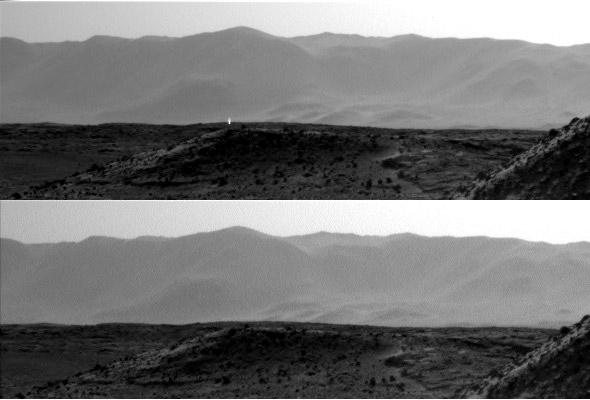No, That’s NOT an Artificial Light on Mars
No, That’s NOT an Artificial Light on Mars
Apparently April is the month to debunk astronomical foolishness, for I have yet another bit of space silliness to disassemble.
Yesterday, the Houston Chronicle ran a story
showing a picture from the Mars Curiosity rover, which has been
exploring the fourth rock from the Sun since August 2012. As the rover
moves over the Martian surface it deploys an arsenal of tools to examine
its environment.
That, of course, includes cameras. Many of the pictures are visually stunning, and some are plain old weird. After all, they’re shots of the landscape on an alien world!
But some folks take the word “alien” a bit too metaphorically. In the Chronicle
article, the writer, Carol Christian, points out one particular picture
(shown above) that depicts a spray of light that looks to be off in the
distance. She wrote, “A NASA camera on Mars has captured what appears
to be artificial light emanating outward from the planet's surface.”
Right, artificial. That’s the first conclusion we
should jump to. But then, instead of asking any of a dozen scientists or
science journalists who might actually be able to supply an answer, she
just quotes the site she got the image from: UFO Sightings Daily.*
Yes, you read that right. The Houston Chronicle is repeating a story they found on a UFO conspiracy site.
When I saw the picture, I knew right away it wasn’t from some
artificial source. It wasn’t even really a light source on Mars! I’ve
worked with astronomical cameras for many, many years, and we see little
blips like this all the time. To make sure though, I asked my friend Emily Lakdawalla, who is also a planetary scientist and journalist. Her immediate response: cosmic ray.
[UPDATE (Apr. 8 at 20:00 UTC): The plot thickens; Justin Maki, a scientist at JPL, says this may be a sunglint off a rock,
and not a cosmic ray. That's certainly possible! As I note below,
though, it only appears in one camera and not the other, so I'm not
quite convinced yet. However, I'll wait a little while and see what
shakes out of this, so I don't post a lot of confusing updates and
corrections! In the meantime, even if it isn't a cosmic ray I can still
be reasonably sure it's not aliens.]
Ah, of course. Cosmic rays
are charged subatomic particles (like protons, electrons, and so on)
zipping around in space. On Earth, our atmosphere absorbs them so they
don’t have much of an effect on cameras down here. But if you put a
telescope in space, they are bombarded by these little beasties. When a
cosmic ray slams into the electronic detector in the camera, it deposits
some energy in the pixel (or pixels) where it hits. These detectors are
designed to detect energy from incoming light, and they can’t tell the
difference between a cosmic ray hit and a photon coming from a distant
star. All they do is register the energy (you can read a lot more about
this on a page where I dismantled claims about Planet X).
And that’s what we have here. Curiosity was taking a picture of the
Martian horizon, and during the time the picture was taken, a subatomic
particle smacked into the camera, leaving behind its trail of energy.
It’s a camera artifact, not a real one.

Photo by NASA/JPL-Caltech
How can I know the light isn’t real, and is just inside the camera itself? Because the camera is the NAVCAM, which is actually two
cameras, one on the right and one on the left. This provides a
binocular view of the landscape, which can be used (just like our own
eyes do) to determine distances to objects. At the same time NAVCAM RIGHT took the picture with the light in it, NAVCAM LEFT also took a picture … and there’s no light. Here are both pictures so you can compare them:
See? It’s in one camera’s picture but not the other, even though they
were taken at the same time (on April 3, 2014, at 10:00:03 UTC).
As you can see, the landscape shifts a bit due to the different
perspectives of the two cameras. The light is in one shot, but not the
other.
I’ll note we see this kind of thing all the time, including in Curiosity images. Here’s one over a rock, for example. It’s not hard to find more if you peruse the Curiosity raw images archive (or the Unmanned Spaceflight forum, where space aficionados post and discuss the latest images from various missions).
So that’s what we have here. It’s not some alien rave, or a stranded
bug-eyed monster signaling for help, or other fanciful fiction. No, it’s
far more mundane, merely the quantized energy deposited by a subatomic
particle that was accelerated in the magnetic fields of an exploded star
and traveled thousands of light years across the galaxy at nearly the
speed of light to finally slam into an electronic camera mounted on a
mobile nuclear-powered laser-eyed chemical laboratory humans sent to
another planet.
Clearly, reality’s not cool enough. We need to add aliens to make this a story.
Sigh.
(My very sincere and very large thanks to Emily Lakdawalla for help on this.)
Labels: Astronomy, Nature, Photography, Science


0 Comments:
Post a Comment
<< Home